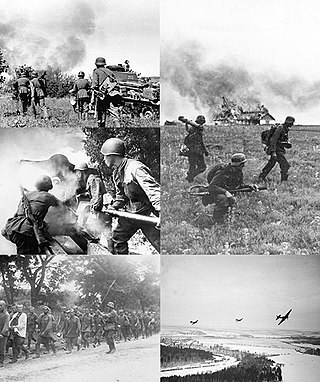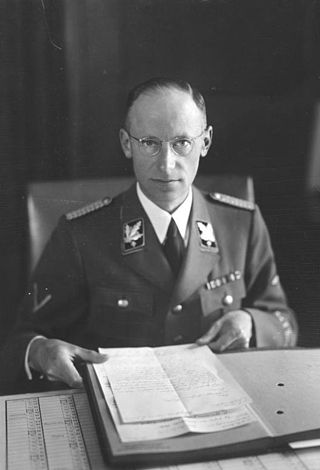
Berthold Konrad Hermann Albert Speer was a German architect who served as the Minister of Armaments and War Production in Nazi Germany during most of World War II. A close ally of Adolf Hitler, he was convicted at the Nuremberg trial and sentenced to 20 years in prison.

Blitzkrieg is a word used to describe a combined arms surprise attack using a rapid, overwhelming force concentration that may consist of armored and motorized or mechanized infantry formations, together with artillery, air assault and close air support, with intent to break through the opponent's lines of defense, dislocate the defenders, unbalance the enemies by making it difficult to respond to the continuously-changing front, and defeat them in a decisive Vernichtungsschlacht: a battle of annihilation.

Nazi Germany was the German state between 1933 and 1945, when Adolf Hitler and the Nazi Party controlled the country, transforming it into a dictatorship.

Operation Barbarossa was the invasion of the Soviet Union by Nazi Germany and many of its Axis allies, starting on Sunday, 22 June 1941, during the Second World War. It was the largest land offensive in human history, with over 10 million combatants taking part. The operation, code-named after Frederick Barbarossa, a 12th-century Holy Roman emperor, Crusader, and German king, put into action Nazi Germany's ideological goal of conquering the western Soviet Union to repopulate it with Germans. The German Generalplan Ost aimed to use some of the conquered people as forced labour for the Axis war effort while acquiring the oil reserves of the Caucasus as well as the agricultural resources of various Soviet territories, including Ukraine and Byelorussia. Their ultimate goal was to create more Lebensraum for Germany, and the eventual extermination of the Native Slavic peoples by mass deportation to Siberia, Germanisation, enslavement, and genocide.

The causes of World War II have been given considerable attention by historians. The immediate precipitating event was the invasion of Poland by Nazi Germany on September 1, 1939, and the subsequent declarations of war on Germany made by Britain and France, but many other prior events have been suggested as ultimate causes. Primary themes in historical analysis of the war's origins include the political takeover of Germany in 1933 by Adolf Hitler and the Nazi Party; Japanese militarism against China, which led to the Japanese invasion of Manchuria and the Second Sino-Japanese War; Italian aggression against Ethiopia, which led to the Second Italo-Ethiopian War, the consent of Western countries to Germany's actions on the annexation of Austria and the partition of Czechoslovakia and Germany's initial success in negotiating the Molotov–Ribbentrop Pact with the Soviet Union to divide the territorial control of Eastern Europe between them.

Home front is an English language term with analogues in other languages. It is commonly used to describe the full participation of the British public in World War I who suffered Zeppelin raids and endured food rations as part of what came to be called the "Home Front".
The Four Year Plan was a series of economic measures initiated by Adolf Hitler in Nazi Germany in 1936. Hitler placed Hermann Göring in charge of these measures, making him a Reich Plenipotentiary (Reichsbevollmächtigter) whose jurisdiction cut across the responsibilities of various cabinet ministries, including those of the Minister of Economics, the Defense Minister and the Minister of Agriculture. The Four Year Plan was part of the alternative governmental structure created by Hitler and the Nazi Party, which included entities such as Organisation Todt and the unification of the Schutzstaffel (SS) and the German police forces, including the Gestapo, under Heinrich Himmler.
Andreas Fritz Hillgruber was a conservative German historian who was influential as a military and diplomatic historian who played a leading role in the Historikerstreit of the 1980s. In his controversial book Zweierlei Untergang, he wrote that historians should "identify" with the Wehrmacht fighting on the Eastern Front and asserted that there was no moral difference between Allied policies towards Germany in 1944 and 1945 and the genocide waged against the Jews. The British historian Richard J. Evans wrote that Hillgruber was a great historian whose once-sterling reputation was in ruins as a result of the Historikerstreit.

Herbert Friedrich Wilhelm Backe was a German politician and SS Senior group leader (SS-Obergruppenführer) in Nazi Germany who served as State Secretary and Minister in the Reich Ministry of Food and Agriculture. He was a doctrinaire racial ideologue, a long-time associate of Richard Walther Darré and a personal friend of Reinhard Heydrich. He developed and implemented the Operation Hunger that envisioned death by starvation of millions of Slavic and Jewish "useless eaters" following Operation Barbarossa, the 1941 invasion of the Soviet Union.

The Zweites Buch, published in English as Hitler's Secret Book and later as Hitler's Second Book, is an unedited transcript of Adolf Hitler's thoughts on foreign policy written in 1928; it was written after Mein Kampf and was not published in his lifetime.

Georg Thomas was a German general in the Third Reich. He was a leading participant in planning and carrying out economic exploitation of the Soviet Union, most notably the Hunger Plan. Thomas's role in plotting against Hitler has led some historians to describe him as a member of the German resistance, while others find his record more ambiguous.

John Adam Tooze is an English historian who is a professor at Columbia University, Director of the European Institute and nonresident scholar at Carnegie Europe. Previously, he was Reader in Twentieth-Century History at the University of Cambridge and Gurnee Hart Fellow in History at Jesus College, Cambridge. After leaving Cambridge in 2009, he spent six years at Yale University as Professor of Modern German History and Director of International Security Studies at the MacMillan Center for International and Area Studies, succeeding Paul Kennedy. Through his books and his online newsletter (Chartbook), he reaches a varied audience of historians, investors, administrators, and others.
The Hunger Plan was a partially implemented plan developed by Nazi bureaucrats during World War II to seize food from the Soviet Union and give it to German soldiers and civilians. The plan entailed the genocide by starvation of millions of Soviet citizens following Operation Barbarossa, the 1941 invasion of the Soviet Union. The premise behind the Hunger Plan was that Germany was not self-sufficient in food supplies; to sustain the war and keep up domestic morale, it needed food from conquered lands at any cost. The plan created a famine as an act of policy, killing millions of people.

Like many other nations at the time, Germany suffered the economic effects of the Great Depression, with unemployment soaring after the Wall Street Crash of 1929. When Adolf Hitler became Chancellor of Germany in 1933, he introduced policies aimed at improving the economy. The changes included privatization of state owned industries, import tariffs, and an attempt to achieve autarky. Weekly earnings increased by 19% in real terms from 1933 to 1939, but this was largely due to employees working longer hours, while the hourly wage rates remained close to the lowest levels reached during the Great Depression. In addition, reduced foreign trade meant rationing of consumer goods like poultry, fruit, and clothing for many Germans.

German rearmament was a policy and practice of rearmament carried out by Germany from 1918 to 1939, in violation of the Treaty of Versailles which required German disarmament after WWI to prevent it starting another war. It began on a small, secret, and informal basis shortly after the treaty was signed, but was openly and massively expanded after the Nazi Party came to power in 1933.
Nazism, the common name in English for National Socialism, is the far-right totalitarian political ideology and practices associated with Adolf Hitler and the Nazi Party (NSDAP) in Nazi Germany. During Hitler's rise to power in 1930s Europe, it was frequently referred to as Hitlerism. The later related term "neo-Nazism" is applied to other far-right groups with similar ideas which formed after the Second World War.
The Ural Mountains played a prominent role in Nazi planning. Adolf Hitler and the rest of the Nazi German leadership made many references to them as a strategic objective of the Third Reich to follow a decisive victory on the Eastern Front against the Soviet Union.
The foreign relations of Third Reich were characterized by the territorial expansionist ambitions of Germany's dictator Adolf Hitler and the promotion of the ideologies of anti-communism and antisemitism within Germany and its conquered territories. The Nazi regime oversaw Germany's rise as a militarist world power from the state of humiliation and disempowerment it had experienced following its defeat in World War I. From the late 1930s to its defeat in 1945, Germany was the most formidable of the Axis powers - a military alliance between Imperial Japan, Fascist Italy, and their allies and puppet states.
Food and agriculture in Nazi Germany describes the food and agricultural policies of Nazi Germany and their consequences from 1933 when the Nazis took power in Germany until 1945 when Germany was defeated in World War II (1939–1945) by the allied nations. Starvation and its associated illnesses killed about 20 million people in Europe and Asia during World War II, approximately the same as the number of soldiers killed in battle. Most of the deaths from starvation in Europe were in the Soviet Union and Poland, countries invaded by Germany and occupied in whole or part during the war.












